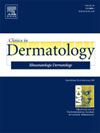皮肤癌人工智能国际出版趋势分析。
IF 2.3
4区 医学
Q2 DERMATOLOGY
引用次数: 0
摘要
我们采用文献计量学方法分析了2010年至2022年有关皮肤癌人工智能的出版物,旨在探索当前的出版趋势和未来的发展方向。我们在 Web of Science 数据库中使用 "人工智能"、"机器学习"、"深度学习 "和 "皮肤癌 "四个术语对 2010 年至 2022 年有关人工智能在皮肤癌中的应用的英文原版出版物进行了全面检索。我们以作者、国家和地区、发表期刊、机构和核心关键词为重点,直观地分析了发表、引用和耦合信息。对 989 篇论文的分析表明,2010 年至 2022 年期间,论文数量逐年增加(0.51% 对 33.57%)。美国、印度和中国成为主要贡献者。IEEE Access 被认为是该领域最多产的期刊。重点期刊和有影响力的作者得到了强调。对被引用次数最多的前 10 篇论文的研究突出了人工智能在肿瘤学领域的巨大潜力。共引网络分析确定了皮肤肿瘤人工智能经典文献的四个主要类别。关键词分析表明,"黑色素瘤"、"分类 "和 "深度学习 "是最常见的关键词,这表明用于黑色素瘤诊断和分级的深度学习是当前的研究重点。色素性皮肤病变 "一词的爆发力最强,持续时间最长,而 "纹理 "则是最新出现的关键词。人工智能是皮肤癌研究中一个快速增长的领域,具有显著改善皮肤癌管理的潜力。未来的研究可能会侧重于用于筛查和诊断目的的机器学习和深度学习技术。本文章由计算机程序翻译,如有差异,请以英文原文为准。
Analysis of international publication trends in artificial intelligence in skin cancer
Bibliometric methods were used to analyze publications on the use of artificial intelligence (AI) in skin cancer from 2010 to 2022, aiming to explore current publication trends and future directions. A comprehensive search using four terms, “artificial intelligence,” “machine learning,” “deep learning,” and “skin cancer,” was performed in the Web of Science database for original English language publications on AI in skin cancer from 2010 to 2022. We visually analyzed publication, citation, and coupling information, focusing on authors, countries and regions, publishing journals, institutions, and core keywords.
The analysis of 989 publications revealed a consistent year-on-year increase in publications from 2010 to 2022 (0.51% versus 33.57%). The United States, India, and China emerged as the leading contributors. IEEE Access was identified as the most prolific journal in this area. Key journals and influential authors were highlighted. Examination of the top 10 most cited publications highlights the significant potential of AI in oncology. Co-citation network analysis identified four primary categories of classical literature on AI in skin tumors. Keyword analysis indicated that "melanoma," "classification," and "deep learning" were the most prevalent keywords, suggesting that deep learning for melanoma diagnosis and grading is the current research focus. The term “pigmented skin lesions” showed the strongest burst and longest duration, whereas “texture” was the latest emerging keyword. AI represents a rapidly growing area of research in skin cancer with the potential to significantly improve skin cancer management. Future research will likely focus on machine learning and deep learning technologies for screening and diagnostic purposes.
求助全文
通过发布文献求助,成功后即可免费获取论文全文。
去求助
来源期刊

Clinics in dermatology
医学-皮肤病学
CiteScore
4.60
自引率
7.40%
发文量
106
审稿时长
3 days
期刊介绍:
Clinics in Dermatology brings you the most practical and comprehensive information on the treatment and care of skin disorders. Each issue features a Guest Editor and is devoted to a single timely topic relating to clinical dermatology.
Clinics in Dermatology provides information that is...
• Clinically oriented -- from evaluation to treatment, Clinics in Dermatology covers what is most relevant to you in your practice.
• Authoritative -- world-renowned experts in the field assure the high-quality and currency of each issue by reporting on their areas of expertise.
• Well-illustrated -- each issue is complete with photos, drawings and diagrams to illustrate points and demonstrate techniques.
 求助内容:
求助内容: 应助结果提醒方式:
应助结果提醒方式:


